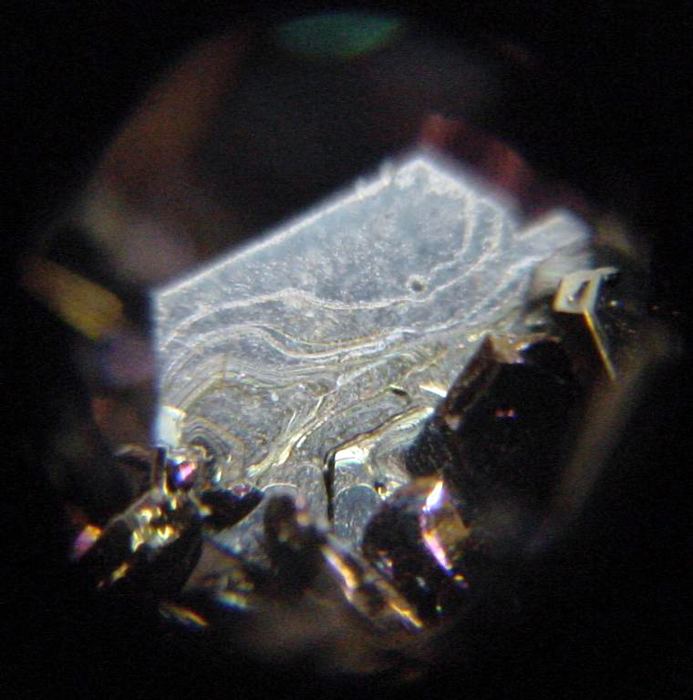Strunz classification 1.DA.05 | Formula(repeating unit) SiC Space group 6H polytype: P63mc | |
 | ||
Crystal system 6H polytype, most common: hexagonal Crystal class 6H polytype: dihexagonal pyramidal (6mm)H-M symbol: (6mm) | ||
Moissanite (/ˈmɔɪsənaɪt/) is the name given to naturally occurring silicon carbide and to its various crystalline polymorphs. It has the chemical formula SiC and is a rare mineral, discovered by the French chemist Henri Moissan in 1893. Silicon carbide is useful for commercial and industrial applications due to its hardness, optical properties and thermal conductivity. Efforts to synthesize silicon carbide in a laboratory began in the late 1800s.
Contents
Background
Mineral moissanite was discovered by Henri Moissan while examining rock samples from a meteor crater located in Canyon Diablo, Arizona, in 1893. At first, he mistakenly identified the crystals as diamonds, but in 1904 he identified the crystals as silicon carbide. Artificial silicon carbide had been synthesized in the lab by Edward G. Acheson just two years prior to Moissan's discovery.
The mineral form of silicon carbide was named moissanite in honor of Moissan later on in his life. The discovery in the Canyon Diablo meteorite and other places was challenged for a long time as carborundum contamination from man-made abrasive tools.
Geological occurrence
Until the 1950s no other source, apart from meteorites, had been encountered. Later moissanite was found as inclusions in kimberlite from a diamond mine in Yakutia in 1959, and in the Green River Formation in Wyoming in 1958. The existence of moissanite in nature was questioned even in 1986 by Charles Milton, an American geologist.
Moissanite, in its natural form, is very rare. It has only been discovered in a small variety of places from upper mantle rock to meteorites. Discoveries have shown that moissanite occurs naturally as inclusions in diamonds, xenoliths, and ultramafic rocks such as kimberlite and lamproite. They have also been identified in carbonaceous chondrite meteorites as presolar grains.
Meteorites
Analysis of silicon carbide grains found in the Murchison meteorite has revealed anomalous isotopic ratios of carbon and silicon, indicating an origin from outside the solar system. 99% of these silicon carbide grains originate around carbon-rich asymptotic giant branch stars. Silicon carbide is commonly found around these stars, as deduced from their infrared spectra.
Physical properties
The crystalline structure is held together with strong covalent bonding similar to diamonds, that allows moissanite to withstand high pressures up to 52.1 gigapascals. Colors vary widely and are graded from D to K range on the diamond color grading scale.
Applications
Moissanite was introduced to the jewelry market in 1998 after Charles & Colvard, formerly known as C3 Inc., received patents to create and market lab-grown silicon carbide gemstones, becoming the first firm to do so. Charles & Colvard currently makes and distributes moissanite jewelry and loose gems under the trademarks Forever One, Forever Brilliant and Forever Classic. Other manufacturers market silicon carbide gemstones under trademarked names such as Amora and Berzelian. Moissanite is regarded as a diamond alternative, with some optical properties exceeding those of diamond. Its lower price and less exploitative mining practices necessary to obtain it make it a popular alternative to diamonds. Due in part to the similar thermal conductivity of moissanite and diamond, it is a popular target for scams; however, higher electrical conductivity and birefringence of moissanite may alert a buyer to fraud. In addition, thermoluminescence is exhibited in moissanite, such that heating it gradually will cause it to change color starting at around 65 °C (150 °F). This color change can be diagnostic for distinguishing diamond from moissanite, although birefringence and electrical conductivity differential are more practical diagnostic differentiators. On the Mohs scale of mineral hardness it is a 9.5, with a diamond being a 10. In many developed countries, the use of moissanite in jewelry was controlled by the patents held by Charles & Colvard; these patents expired in August 2015 for the United States, and will expire in 2016 in most other countries except Mexico, where it will remain under patent until 2018.
Because of its hardness, it can be used in high-pressure experiments, as a replacement for diamond (see diamond anvil cell). Since large diamonds are usually too expensive to be used as anvils, synthetic moissanite is more often used in large-volume experiments. Synthetic moissanite is also interesting for electronic and thermal applications because its thermal conductivity is similar to that of diamonds. High power silicon carbide electronic devices are expected to find use in the design of protection circuits used for motors, actuators, and energy storage or pulse power systems.
